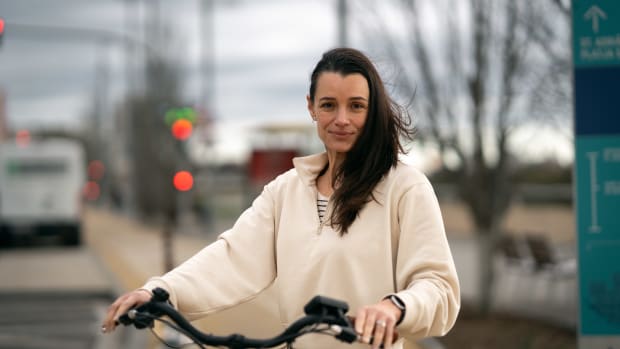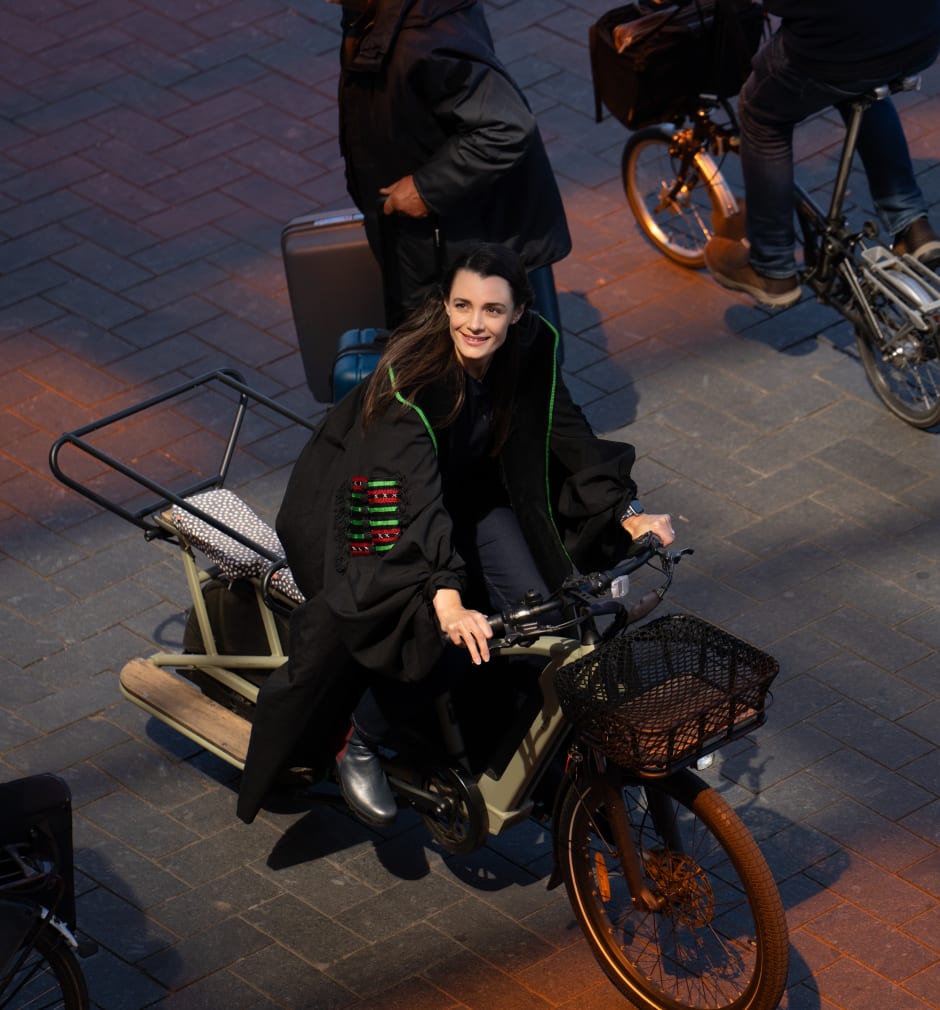
How can you cycle safely through Amsterdam as a newcomer? The cycling professor gives advice
Teenagers speeding by on fat bikes, confused tourists on the cycle path, or parents on cargo bikes who think they own the road. With more bikes than residents, Amsterdam’s cycle traffic can be quite intimidating for newcomers. That’s why Folia asked cycling professor Meredith Glaser for some tips. How can the new batch of students ensure they survive their bike rides through Amsterdam unscathed?
Now that the new academic year is starting and the youngest generation of students is busy getting to know their new fellow students and housemates, Amsterdam’s bicycle traffic is welcoming a lot of newcomers. Whether you’re an 18-year-old student from Beijing or the Betuwe, getting on a bike in the capital can be quite a challenge at first, as cycling professor Meredith Glaser understands. And yet, she argues, it’s important that new students do it too. “As a society, we’re not doing particularly well. Teenagers are struggling with mental health issues, many young people are overweight, and the climate is changing. Cycling can be part of the solution to several of these urban problems.”
Glaser, lecturer in urban development at the UvA, cycling professor at Ghent University, and director of the NGO Urban Cycling Institute, continues: “Whether it’s social science, healthcare or sustainability, we look at everything through the lens of cycling. Take health, for example. It has been clearly demonstrated that cycling every day leads to a longer and healthier life, higher work productivity, better cognitive functions and reduced cardiovascular disease.”
Social cohesion
In terms of social cohesion, Glaser also considers the bicycle to be a unique mode of transport. “You are much more exposed to your immediate surroundings and the people around you than you are in a car or on public transport. At the same time, your range is much greater than when you walk. So you really take in your surroundings. You feel the weather conditions, see the landscape, and smell the bakery or the perfume of someone cycling next to you. You might even strike up a conversation at the traffic lights. That exposure to others makes us feel connected to the world around us.”

And where better to study all these effects than in Amsterdam, perhaps the cycling capital of the world? “It’s no coincidence that the Urban Cycling Institute was founded here in Amsterdam,” says Glaser. “Numerous international delegations come here to learn about cycling policy. This city is the perfect training arena for both engineers and policymakers, and can serve as a source of inspiration.”
Advice
Nevertheless, despite her praise for Amsterdam and its cycling culture, Glaser admits that it can take some getting used to when new residents first join the city’s cycling traffic. “My first tip would therefore be: you do you. Do what feels right for you. Every individual behaves differently on a bicycle, depending on all kinds of aspects of their identity. Do you have experience? Do you feel confident? Then you may well cycle through the city with the greatest of ease. But if you come from somewhere where cycling is not the norm, or if you can’t cycle at all, then you’ll probably be well outside your comfort zone at first. So listen carefully to your own feelings."
Her next piece of advice is to find a cycling buddy. “Cycling is a social activity, and cycling together is completely accepted. With a cycling buddy – ideally someone who is perhaps a little more experienced – you will find it easier to get used to cycling in Amsterdam. This is a particularly enjoyable activity for women. Think, for example, of the feeling of safety that cycling together can provide.”
Once you’ve taken your first steps on a bike, it’s time to relax, continues the cycling professor. “Challenge yourself to get into the flow. A mental state in which you slowly start to daydream and lose track of time. This usually happens after four or five consecutive days of cycling the same route. You know exactly where you are and how to cycle, and you enter a kind of relaxed mode, while still remaining focused.”
At the same time it’s important to remember to change your route significantly after a while, Glaser advises. “Cycling is the perfect way to get to know the city. So take a completely different route every now and then and discover new corners of Amsterdam. This will help you navigate independently and use landmarks to find your way around. It also trains your cognitive functions.”
Unwritten rules
Of course, there are rules and laws that every cyclist must obey, but according to Glaser, you’ll learn those quickly enough. “Observe others. Just stand at a busy intersection for ten minutes and you’ll know all the rules of the road, including the unwritten rules and cultural norms.“ She laughs: “For example, how you’re supposed to indicate your direction with a very limp hand, or how it seems to be a goal in itself for cyclists to keep their feet off the ground as much as possible when they have to stop for a moment.”
1. You do you.
2. Find a cycling buddy.
3. Go with the flow.
4. Change up your routes.
5. Observe others to learn the rules.
6. Fix it yourself.
A good spot to observe? “Behind Central Station, where there are loads of cyclists and pedestrians getting off the ferry. It’s a beautiful ballet of human negotiation when you look at it through anthropological glasses. Even if you tried to disrupt the traffic, you wouldn’t get hurt, because the flow of traffic always finds a way around you.”
And once you’ve mastered the technique, the rules of traffic and all the cultural details, be sure to treat your bike with a little love. “A bicycle is relatively easy to maintain, so learn how to fix it yourself. Pump up your own tyres, apply some oil to the chain and replace the brakes yourself. Sign up for this at the UvA Bike Kitchen, for example. After all, you’re here as a student to learn something, and you’ll benefit from it for the rest of your life.”

